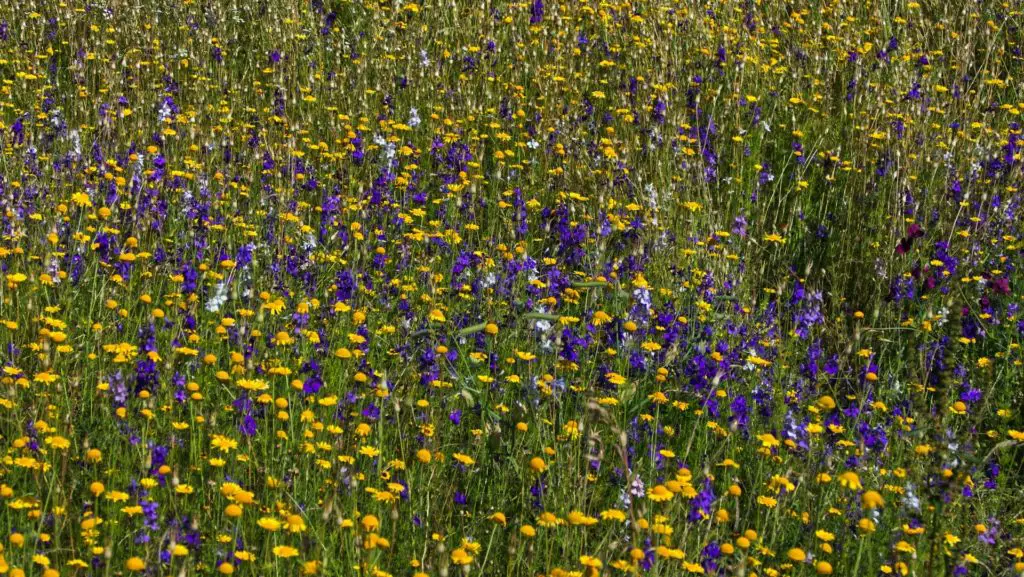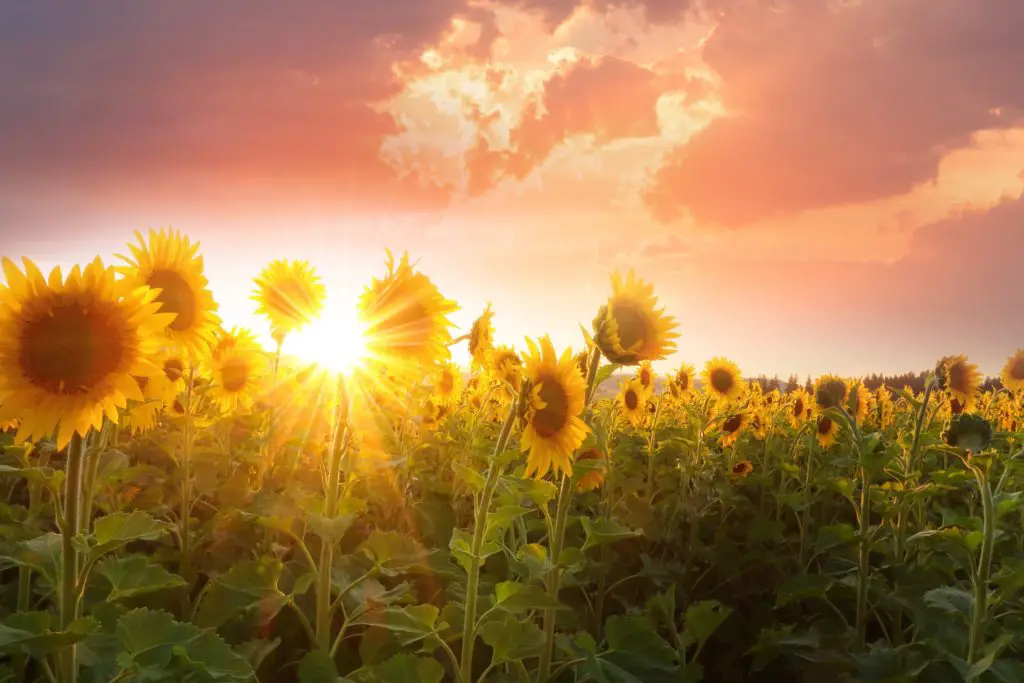As its name indicates, grasslands are areas in the world where grasses dominate the lands. Other plants like trees and big shrubs cant grow in the grasslands, because of the nature and conditions of those lands.
Fire is a common phenomenon in grasslands. Only plants that can handle the flames can survive. And guess which ones can! yes, grasses do.
Grasses are doing great in surviving the fire’s flames. And this is because of their growth center is located under the ground.
So fires only burn the upper part of the grasses ( stem, leaves, and flowers).
After the end of the fires, grasses grow fast again from the ground. While trees cant survives frequent fires that occur in the grasslands because of their growth center located above the ground.
Such a thing makes them vulnerable to fires. Besides, the speed of trees growth can’t keep up with the frequent fires.

Grasslands are home for many animals who learned to run fast to survive fires. Those animals feed on grassland plants. And they prefer to eat shrubs and trees. Because grasses are not easy to eat.
Actually some grasses have a very sharp leaf blade that can injure your hand if you rub it.
Therefore animals will choose trees and shrubs over grasses to feed on. Those factors with others made grasses and grass-like plants like sedges dominate the grasslands.
Grasses survive the fires and grazing. While shrubs and trees are eaten and burned to death.
Grasslands plants list
1. Milkweed
Milkweed is native to the temperate grasslands of South America, It has beautiful red and yellow blossoms.
And known for attracting bees, butterflies, and hummingbirds.
This wildflower can grow to reach 3.5 feet tall. The milk that associated with its name is a poisonous sab.
milkweed evolved to have such poisonous sab to not be eaten by grazers and animals in grasslands.
Native Americans used milkweed heavily in their traditional medicine.
They made salve to heal wounds from milkweed roots. Also, they believed that drinking milkweed’s leaves tea can prevent pregnancy.
While science confirmed that the roots of milkweed contain properties that heal wounds. But it didn’t found any proof for the pregnancy prevention claim.
2. Clover plant
Animals find clover very tasty and pleasant to eat. farmers realized this fact and started to grow it in mass scale as livestock feed.
It contains rich nutrients such as protein, phosphorus, and calcium.
Another reason that made clover attractive grass is it improves and conserves the soil. It abundantly adds nitrogen to the soil.
And make the soil richer in terms of nutrients for flowing crops.
3. Sunflowers
Sunflowers are the bless of grasslands! They have both high economic and ornamental value. sunflowers have a hairy stem. And can reach up to 15 feet high.
It has an iconic and unique yellow flower. Actually it defines the yellow color in nature.

Besides its beauty, almost every part of the sunflower is very useful. People use their seeds to produce oil.
And they use their leaves to feed their stocks. Also, the flower produces high-quality yellow paint.
Japanese planted millions of sunflowers after the tsunami destroyed the reactors in the nuclear power plant. They did so because sunflowers are good at absorbing toxins.
4. Buffalo grass
Buffalo grass is a typical grassland plant. it is native to temperate grasslands. Where there is a very cold winter. And a lot of droughts. Buffalo grass adapted very well to those conditions.
It goes dormant and turns to the brown color in the cold season. And grow back very fast at the beginning of spring.
Since there is moderate to low rainfall in temperate grassland, buffalo grass tends to grow as short grasses.
5. Lupines
This beautiful wildflower is native to grasslands. It is elegant and looks like a classy lady wearing a simple dress! It’s white and blue flowers combined with a 4 feet tall give such an impression!
With all this beauty, it also a strong plant, that can stand severe cold by going dormant. After surviving the cold season, it grows back. And honor the grasslands with its classy presence!
Grasslands climate and how it affects its plants
Grassland is the biggest biome on earth. it represents around 40% of earth’s lands. It has moderate rainfalls, that less than the foreset’s rains, but more than the desert’s rains.
It resides in the middle between forest and desert both in rainfall levels and location. The extremes and edges of grasslands are either the beginning of a forest or desert.
The average rainfall in grasslands is 20 to 35 inches a year. Such amount of rainfall is enough to support the growth of grasses which keeping it from being a desert.
Although it is not enough to support the growth of trees which kept it from turning to a forest.
Actually, according to scientific studies a very long time ago, grasslands were once forests, but it turned to what it is today because of the change in the rainfall levels.
in the world’s grasslands, the rainfall level differs from one to another. But general rule the average grasslands rainfall is moderate (less than forests but more than deserts).
Grasslands that have higher rainfall tend to have taller grasses. While the ones with fewer rainfalls have shorter grasses.
There are two types of grasslands classified according to their climate and weather conditions:
Types of grasslands
Tropical grasslands
This is the grasslands where rainfalls relatively higher than the other one. It has dry and wet seasons. But the weather is almost warm throughout the whole year.
such weather allows few shrubs and trees to grow but grasses still dominate. Tropical grasslands have taller grasses due to their higher rainfall level.
Temperate grasslands
Temperate grasslands, in general, have a lower level of rainfall when compared to tropical grasslands.
It has cold winter, the temperature degree can reach 0 degrees Fahrenheit.
Fortunately, plants in this grasslands evolved to go dormant during winter. And grow back very quickly at the beginning of the growing season.
In summer temperature can exceed 90 degrees Fahrenheit.
The grasses in such grasslands are shorter than the tropical ones.
And there are no trees and shrubs in temperate grasslands due to the low amount of rainfalls.
Grasslands plants grow in rich soil
The soil of grasslands is the richest soil (high nutrients and fertile) comparing to other biomes.
This happens because there is a lot of decaying organic matter that falls frequently in the topsoil.
As I mentioned before grassland has frequent fires. Those fires burn the upper plant’s part, and the aches fall in the soil consistently. Such a thing caused grasslands to have the richest soil.
A big portion of the world’s grasslands turned to agricultural fields. because of the richness of its soil.
The crops that feed the world are actually grown in fields that once were natural grasslands.
Grasslands plants adaptions
As any biome in the world has it’s unique conditions and demands. Grasslands are no exception to this fact.
In grasslands, there are several challenges that every plant should adapt to it. If it wants to be a resident.
Below are the common grassland’s plants adaptions techniques:
Low or underground growth centers
Due to frequent fires in the grasslands plants adapt to have their growth center under the soil.
Therefore when fires come, the plant’s core stays safe. The fire only burns the plant’s part that is replaceable.
After the fire ends the plant starts to grow very fast from the ground.
Grasslands plants have strong roots
Since there is a tough drought season in the grasslands. Grasses have strong roots that can go deep in the soil to reach water sources.
Handling cold weather
In the temperate grasslands where temperature can reach 0-degree Fahrenheit. Grasses evolved to live happily under a heavy layer of snow.
While some grasses go dormant during extreme cold and grow back very quickly at the start of summer.
The grassland plants have long and narrow leaves
Since the rainfalls are limited in grasslands. grasses developed long and narrow leaves to use water more efficiently.
Surviving strong winds
Trees act as a windshield for other plants. Unfortunately, grasslands plants haven’t that privilege.
Therefore they acted by developing elastic leaves and stems. Those stems and leaves bend without breaking when winds hit.
Grassland plants can survive graze
Grasslands are full of hungry animals who want to eat almost all day. plants in grasslands dealt with this challenge through different techniques.
for example, most grasses in grasslands have a sharp leaf blade which can injure animals if they try to eat it.
Also, grasses evolved to develop an unfavorable taste. Therefore they became less likely to be eaten when there are shrubs and trees around.
This fact is one of the reasons that make grasslands have no to little shrubs and trees.
Animals eat them aggressively and at the same time, their rate of growth cant cope with the rate of grazing.
Another feature grasses have which helps them to stand grazing is they grow back very fast after being grazed.
